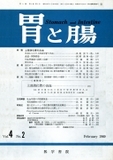Japanese
English
- 有料閲覧
- Abstract 文献概要
- 1ページ目 Look Inside
Ⅰ.緒言
上部消化管から大出血を起す疾患のうち,胃十二指腸潰瘍,胃癌,食道静脈瘤については,古くから出血源および出血機序が知られており,個々の病態に応じた診療が行なわれている.この他まれな疾患として食道裂孔ヘルニヤ,食道憩室,その他の食道疾患,Mallory-Weiss症候群,胃ポリープ,胃血管腫,十二指腸憩室,肝・胆道・膵疾患などが挙げられるが,これら疾患の発見されない症例も多数報告されており,Gastrostaxisないし特発性実質性胃出血と呼ばれていた1)~3).このなかには,胃粘膜びらんからの出血像を確認できたものもあるが,びらんを認め得なかったとする報告も少なくない4)~10).
筆者らは1949年以来臨床外科医の立場にたって胃炎出血ないし慢性胃炎の問題を研究し,胃炎出血の頻度はまれでなく,再出血の危険も大きいことを発表してきた11)~20).しかし大出血時の胃炎出血の診断や治療方針の決定については種々議論のあるところであり,さらに胃炎出血の成因に関しては不明の点が多く,今後の研究に待たねばならないと考える.今回は教室開設以来13年間に経験した胃炎出血の症例について検討し,若干の考察を加えた.
Thirty five cases of chronic gastritis with hematemesis or melena, treated in our clinic from 1955 to 1968, were studied as to the clinical picture, method of diagnosis, surgical treatment and its results, pathological findings of the resectecl stomach, and so on. In an analysis of 255 cases of overt upper gastrointestinal bleeding during the same period, the most frequent cause of bleeding was gastroduodenal ulcer (52.6%), the second being gastric cancer (18.4%), the third chronic gastritis (13.3%).
Most of the bleeding from gastritis is slight or moderate and stops easily, but bleeding often recurs. Symptoms of chronic gastritis other than bleeding are epigastralgia, heart burn, epigastric fullness, nausea, vomitting, anorexia, and so forth, having much in common with the symptoms of gastro duodenal ulcer.
The diagnosis of hemorrhagic gastritis is very difficult because it has no specific findings in its history, state of bleeding, physical examination, or roentgenolgical study. Observation of bleeding from gastric mucosa by early endoscopic examination, and complete exclusion of other diseases which can produce upper gastrointestinal bleeding are necessary to confirm the diagnosis of hemorrhagic gastritis. Correct diagnosis was made only in twelve cases; nineteen were diagnosed gastroduodenal ulcer, two as gastric cancer, one as pylorus stenosis, and one as duodenal diverticula.
The plan for treating hemorrhage from gastritis must depend on the magnitude of bleeding because of diagnostic difliculties in the early stage; in some instances even emergency operation becomes mandatory to save the life of individual patients.
In our 35 cases, conservative therapy in the acute stage was effective to stop the bleeding. Twenty seven cases were operated on, in the intermediate stage or in the interval stage of bleeding, on the diagnosis of gastroduodenal ulcer, chronic gastritis, gastric cancer, etc. Partial gastrectomy was performed in 25 cases and gastrotomy withont resection in 2 cases. The other 8 cases were treated medically after the bleeding had stopped.
Erosions were found macroscopically in the resected stomach in 10 cases of 15 intermediate operations and in 3 cases of 10 interval operations. Microscopically most of them were healed erosions; and more minute, invisible erosions and hemorrhage in the tunica propria mucosae were recognized.
Late results of gastric resection for hemorrhagic gastritis are analysed in 16 cases. Bleeding after drinking recurred only in one case. Symptoms other than bleeding are slight, and most of the patients can eat and work the same as before or better than the preoperative period. In the follow-up study of medically treated patients, one was found to have died of recurrent hematemesis.
It is concluded thal chronic gastritis in which hematemesis or melena recurs has an indication for surgical therapy, and that the results of the operation are fairly good as compared with those of gastroduoclenal ulcer operations.

Copyright © 1969, Igaku-Shoin Ltd. All rights reserved.


